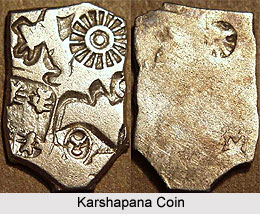 Representing India`s earliest numismatic issues, the punch-marked coins are popularly known as karshapanas. Panini (4th century B.C.), the great Indian grammarian, was the first to use the name karshapana for these coins. Kautilya`s Arthashastra (4th century B.C.) refers to these coins as pana. The Buddhist Jatakas (4th-lst centuries B.C.?) refer to these coins as kahapana.
Representing India`s earliest numismatic issues, the punch-marked coins are popularly known as karshapanas. Panini (4th century B.C.), the great Indian grammarian, was the first to use the name karshapana for these coins. Kautilya`s Arthashastra (4th century B.C.) refers to these coins as pana. The Buddhist Jatakas (4th-lst centuries B.C.?) refer to these coins as kahapana.
These punch-marked coins were circulated as currency in different parts of the subcontinent from around the 6th century B.C. and in some places, especially in South India, even up to the 1st century A.D. and slightly later. They were first produced in North India and they travelled to South India through traders, Buddhist and Jain monks and pilgrims. Subsequently, they were produced in South India too.
The southern fringes of the distant Mauryan Empire which included the Andhra-Karnataka region, has yielded several large hoards of punch-marked coins. The major hoards from this region include Karimnagar, Nasthullapur, Amaravati, Singa-varam and Weepangandla in Andhra Pradesh and Raichur, Gulbarga and more recently, Chikka Sindogi in Karnataka. Besides, such coins occur in the stratified context in excavated sites such as Amaravati, Kondapur, Bhattipprolu, Vaddamanu, Salihundam, Gudimallam and Veerapuram in Andhra and Maski, Chandra-valli, Banavasi and Vadagaon Madhavapur in Karnataka.
Even in Tamil Nadu and Kerala, which was definitely outside the limits of the Mauryan Empire, several interesting hoards of punch marked coins have been discovered. The major hoards from Tamil Nadu include Mambalam, Kayadi, Navalai, Pennar, Tondamanadian, Bodinayakkanur and Virasga-mani. The important hoards from Kerala are Kottayam (or Elikulamkara), Eyyal, Maala and Angamali (or Kodussery.) In the stratified context, significant finds of punch-marked coins come from Kaveripumpattinam, Kodumanal, Kallupatti, Alagankulam and Korkai in Tamil Nadu.
Besides the hoard finds and the stratified finds, stray occurrences of punch-marked coins are known from scores of sites in South India, mainly in Andhra and Tamil Nadu. The finds are heavily concentrated around Duwuru and Nellore in Andhra (close to the Tamil Nadu border) and Tirukoilur and Karur in Tamil Nadu. Very recently, a surface-find of a batch of six punch-marked coins has been reported from Ramanathapuram, close to Ramesvaram (Tamil Nadu) almost on the peninsular tip of India. Tamil Nadu has even yielded many such coins within megalithic graves in places such as Chavadipalaiyam near Coimbatore. Many of these stray finds have not been published and are now in private hands.
Even the island of Sri Lanka has yielded thousands of punch-marked coins. For instances, Anuradhapura, an extensive early historical site of the island, has revealed such coins in the stratified context. Ancient inscriptions in the island refer to the use of these coins in those regions. The earliest such inscription is a Brahmi epigraph of the late 3rd century B.C.
The punch-marked coins are generally made of silver and rarely, of copper. Even the silver coins are often alloyed with copper with a minor percentage of lead and iron.
Symbols were stamped on the metal blanks to transform them into coins. Probably, the blanks were slightly heated before the symbols were stamped. The symbols were stamped, one after the other, at various points on the blank, with punches, each punch having one distinct symbol. Hence, the popular name `punch-marked coin.`






































